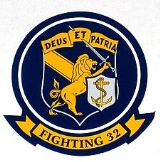
VFA-32
Encyclopedia
The "Fighting Swordsmen" of Strike Fighter Squadron THIRTY-TWO (VFA-32) are a United States Navy
strike fighter
squadron presently flying the F/A-18F Super Hornet and based ashore at Naval Air Station Oceana
. Their radio callsign is Gypsy and their tail code is AC.
Their mission is: "Strike Fighter Squadron THIRTY-TWO, as a part of United States Naval Aviation, utilizes the F/A-18F aircraft to project power ashore and at sea, to defend the Fleet against air and sea threats and to carry out all other missions which may be assigned by cognizant authority."
Two distinct squadrons have been designated VF-2.. The first VF-2 was established on 1 June 1943 and was disestablished on 13 November 1945. The second VF-2 eventually became VFA-32, and is the subject of this article.

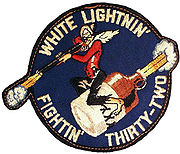 Originally, the squadron used the Fighting Three Felix the Cat
Originally, the squadron used the Fighting Three Felix the Cat
symbol and called themselves the "Crazy Cats" because so many pilots were from Fighting Three. At one time, the squadron was known as the "White Lightning." In 1950, the squadron adopted the insignia of a traditional heraldry lion under Naval Aviation wings of gold and the motto "Deus et Patria" that has endured with only slight modernization through today. The VF-32 squadron radio callsign is "Gypsy" and most alumni refer to themselves as "Gypsies". The squadron picked up the nickname Swordsmen after it switched to the F-8 Crusader and added a sword to the lion's hand.
, when it was split off from VF-3
, the famed Felix squadron. Fritz Wolf, a former member of the American Volunteer Group
(AVG) or Flying Tigers
, was assigned as the first VBF-3 commanding officer. At the time, U.S. Navy carriers were closing on the Japanese home islands and were facing aggressive Kamikaze
attacks.
VBF-3 was assigned to Carrier Air Group THREE on board in the Pacific theater.
On 16 February 1945, VBF-3 pilots became the Navy's first carrier-based pilots to strike the Japanese islands. During the heavy action on that day, the squadron shot down 24 Japanese aircraft, earning the Presidential Unit Citation.
On 15 November 1946, VBF-3 was redesignated VF-4A and switched to the F8F-1 Bearcat
. On August 7, 1948, VBF-3 became VF-32 and switched to the F4U Corsair
.
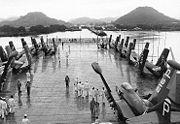 In 1950, the Swordsmen were deployed to the Korean War
In 1950, the Swordsmen were deployed to the Korean War
with F4U Corsair
s aboard . From October 1950 to January 1951, VFA-32 hit Korean targets including Wonsan
Harbor, Puckchong, Chonjin, and Chosin Reservoir
. On December 4, 1950, the aircraft of Ensign
Jesse L. Brown
, the first Black American Naval Aviator
, was hit by flak while supporting embattled Marines at Chosin. He crash-landed his Corsair behind enemy lines on a snow-covered mountain slope. His wingman, Lieutenant (Junior Grade) Thomas J. Hudner, Jr.
, could see that Brown survived the forced landing, but appeared to be trapped in the cockpit with smoke coming from the engine compartment. In an attempt to save his squadron mate, Hudner crash-landed his plane alongside Browns'. Hudner found Brown semi-conscious, but was unable to extricate him from the crumpled fuselage. Brown died in Hudner's arms, and although the attempted rescue failed, Hudner received the Medal of Honor
and Brown received the Distinguished Flying Cross
.
 After the Korean war ended in November 1952 the squadron returned to the East Coast and became the first squadron to operate the swept-wing F9F-6 Cougar. VFA-32 made subsequent deployments aboard in 1953 and the in 1955. In 1956, VF-32 became the first squadron to transition to the F8U-1 Crusader
After the Korean war ended in November 1952 the squadron returned to the East Coast and became the first squadron to operate the swept-wing F9F-6 Cougar. VFA-32 made subsequent deployments aboard in 1953 and the in 1955. In 1956, VF-32 became the first squadron to transition to the F8U-1 Crusader
, thus becoming the first supersonic
squadron in the Navy.
While deployed aboard as a unit of Carrier Air Group THREE, VFA-32 participated in the 1958 Lebanon crisis.
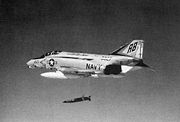 During the Cuban missile crisis
During the Cuban missile crisis
in late 1962, VF-32 flew 96 sorties to support photoreconnaissance flights and intelligence-gathering missions. After returning from cruise in 1965, the squadron changed homeport from NAS Cecil Field, Florida to NAS Oceana, Virginia, and switched to the F-4B Phantom II. VF-32 detached from Carrier Air Group THREE, ending a relationship that had lasted since the squadron's establishment.
In June 1966, VF-32 embarked aboard as a component of Carrier Air Group ONE and sailed for Yankee Station
in Southeast Asia. The squadron flew 940 combat sorties during three line periods in five months, building a highly successful Vietnam War
combat record, losing no aircraft or aircrew. In May 1968, VF-32 deployed aboard for her maiden voyage
.
 In 1971, the squadron received the Meritorious Unit Commendation for actions in support of SIXTH FLEET operations during the Middle East Crisis.
In 1971, the squadron received the Meritorious Unit Commendation for actions in support of SIXTH FLEET operations during the Middle East Crisis.
In 1974, VF-32 switched to the F-14 Tomcat
at NAS Miramar before moving to NAS Oceana as one of the first fleet Tomcat squadrons based there. VF-32 made the first Atlantic Fleet F-14 deployment in June 1975. On that cruise, VF-32 was awarded the Admiral Joseph Clifton Award as the Navy's top fighter squadron. In October 1977, VF-32 became the first fleet squadron to fly against the Air Force F-15 Eagle
, setting the stage for regularly scheduled dissimilar air combat training between the Air Force and Navy. VF-32 again embarked for the Mediterranean aboard Kennedy in June 1978. During this deployment, VF-32 conducted the first fleet test and evaluation of the new Television Camera System. The Swordsmen also deployed with AIM-9L Sidewinder
missiles for the first fleet captive-carry evaluation. A mid-cruise missile exercise, "BUZZARDEX", was an unqualified success with firings of AIM-54 Phoenix
and AIM-7 Sparrow
missiles at five targets moving at Mach
2.5. In October 1979, VF-32 completed 10 years of accident-free flying. In those 10 years, the squadron flew over 33,000 hours, including 17,000 in the F-14A.
In 1983-84, the Swordsmen completed the Navy's first combat deployment since the Vietnam era with CVW-6 aboard Independence. Fighter Squadron 32 flew combat air patrol missions and provided TARPS imagery for the 4 December 1983 CVW-6/CVW-3 air strikes on Syrian positions in Lebanon
and flew missions in support of Operation Urgent Fury in Grenada
providing pre- and post-battle damage assessment using photography from the TARPS pod. This was the first combat operation using all branches of the military since Vietnam. The deployment concluded with participation in NATO exercise "TEAMWORK 84" in the Norwegian Sea. The Swordsmen made a third deployment aboard Independence from October 1984 through February 1985 to the Mediterranean and Indian Ocean.
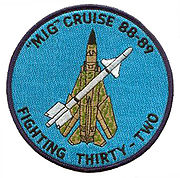 The Swordsmen rejoined CVW-3 in February 1985, and embarked aboard Kennedy in August 1986 for another Mediterranean deployment. This cruise saw the Swordsmen Class "A" safety record extended another year, but also included the first night F-14 barricade landing. VF-32 participated in a variety of NATO and combined exercises, and extended their major mishap-free safety record to nine years during a 1988-89 Mediterranean deployment, again aboard Kennedy.
The Swordsmen rejoined CVW-3 in February 1985, and embarked aboard Kennedy in August 1986 for another Mediterranean deployment. This cruise saw the Swordsmen Class "A" safety record extended another year, but also included the first night F-14 barricade landing. VF-32 participated in a variety of NATO and combined exercises, and extended their major mishap-free safety record to nine years during a 1988-89 Mediterranean deployment, again aboard Kennedy.
On January 4, 1989, while flying from Kennedy during a routine patrol over the Gulf of Sidra
, two VF-32 F-14s intercepted two Libya
n MiG-23 Floggers, which had originated from the Al Bumbai airfield in Tobruk
. After attempting a peaceful intercept, the F-14s used their Television Camera System (TCS) to verify that the MiGs were armed. Hostile intent was declared and the Swordsmen were cleared to engage. The lead fired an AIM-7 Sparrow
, which failed to track. His wingman also fired a Sparrow, which tracked and destroyed one of the MiGs, its pilot ejecting. The first F-14 then closed to AIM-9 Sidewinder
range and downed the remaining MiG-23, whose pilot also ejected. The Swordsmen and Kennedy returned to Virginia in February 1989.
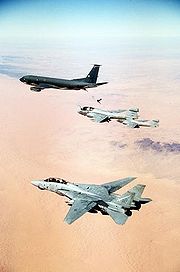 When Kuwait was invaded by Iraqi forces in August 1990, VF-32 joined Carrier Air Wing 3, was put on emergency recall from Nellis AFB and returned to NAS Oceana to prepare to sortie with Kennedy. Kennedy immediately proceeded to the Red Sea
When Kuwait was invaded by Iraqi forces in August 1990, VF-32 joined Carrier Air Wing 3, was put on emergency recall from Nellis AFB and returned to NAS Oceana to prepare to sortie with Kennedy. Kennedy immediately proceeded to the Red Sea
to participate in Operation Desert Shield alongside . During Desert Shield, the ship made several Suez Canal
transits and operated in the Eastern Med. When Desert Shield turned into Operation Desert Storm in January 1991, VF-32 Tomcats were in the first strike wave flying Combat Air Patrol
mainly in central and western Iraq. VF-32 TARPS aircrews flew daily missions throughout Iraq including supersonic runs over highly defended Al Qa'im. Throughout Operation DESERT STORM, VF-32 aircrew logged 1,445 combat flight hours on 403 missions, including 38 combat TARPS missions. After an eight month deployment, the Swordsmen returned to NAS Oceana on 28 March 1991. Later that year, the Swordsmen won the 1991 AIRLANT Grand Slam missile firing competition with an unprecedented 17 of 17 scored kills. Fighting 32 and the Kennedy again deployed in October 1992. The Gypsies conducted a great deal of air-to-ground operations while on cruise, marking the beginning of the Tomcat strike/fighter mission. The Swordsmen returned home to NAS Oceana in April 1993 and throughout the summer conducted joint ACM exercises with the Air Force. The year was highlighted with presentations of the Battle "E" and Clifton Awards to VF-32.
In May 1994, VF-32 and CVW-3 embarked aboard . This four-week deployment marked the first extensive at-sea period where women worked alongside men on a fleet aircraft carrier. In September, a small detachment provided crucial TARPS photography and air support for Operation Restore Democracy in Haiti
. In November 1994, VF-32 deployed aboard Eisenhower for another tour in the Mediterranean and the Indian Ocean
. The Gypsies flew missions over Iraq in support of Operation Southern Watch
and over Bosnia-Herzegovina in support of Operation Deny Flight
. 1995 marked fifty years of service from the men and women of VF-32. In November 1996, VF-32 and CVW-3 deployed on board for another tour in support of Operation Deny Flight and OSW over Bosnia and Iraq. The cruise proved to be yet another milestone as the Gypsies brought digital imagery to the TARPS mission. The new cameras could take up to two hundred digital images and was able to store them on board or transmit them to appropriately equipped ground or sea based receivers up to 300 kilometers away, resulting in a near-real-time reconnaissance capability. The squadron received the Meritorious Unit Commendation for its cutting edge work with Digital TARPS. In August 1997, the Swordsmen of VF-32 began transitioning from the F-14A to F-14B. In February 1998, the Swordsmen received the F-14B Upgrade.
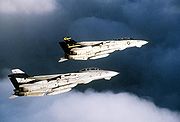 In November 1998, VF-32 and CVW-3 deployed aboard to the Persian Gulf and Mediterranean Sea to support OSW and Operation Deliberate Force. With Iraq
In November 1998, VF-32 and CVW-3 deployed aboard to the Persian Gulf and Mediterranean Sea to support OSW and Operation Deliberate Force. With Iraq
’s failure to cooperate with United Nations
inspections of known weapon sites, Operation Desert Fox
was launched on December 16, 1998. F-14Bs from VF-32 took part in a 33-aircraft strike package on December 16. The first night of the four day operation was conducted by the US Navy only. Over four days, VF-32 expended 111054 lb (50,373.2 kg) of ordnance during 16 strike missions and 38 sorties. During Desert Fox many Tomcat firsts were achieved, including the first GBU-24s dropped in combat by the US Navy, the first multiple GBU-24 drop by any platform in combat, the first combat use of the LANTIRN, the first autonomous F-14 delivery of a GBU-10/16/24, and the first F-14 use of Night Vision Devices in combat. The Swordsmen returned home in May 1999.
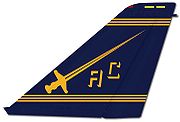 VF-32 deployed once again in November 2000 for the maiden voyage
VF-32 deployed once again in November 2000 for the maiden voyage
of the . They spent four months in support of Operation Southern Watch
and returned home on May 23, 2001.
In December 2002 VF-32 deployed once again on Truman in support of Operation Noble Eagle
and Operation Northern Watch
.
In support of Operation Iraqi Freedom (OIF) in 2003, VF-32 was deployed to the Mediterranean Sea
aboard Truman. VF-32 flew strike missions and missions in support of US Special Forces
on the ground. VF-32 was involved in the worst friendly fire
incident of the war when on April 6, 2003 a squadron F-14 crew was cleared to attack an Iraqi tank near Dibakan, 30 miles (48.3 km) south east of Mosul
. Instead, they mistakenly dropped a single laser-guided bomb
on a vehicle convoy consisting of US Special Forces and Kurdish
resistance fighters, killing 18 Kurdish fighters, 4 US soldiers and a BBC
translator. An additional 80 people were wounded. An investigation following the war found that the pilot had been cleared to drop without the benefit of target coordinates provided by the Forward Air Controller, who was “operating under great stress” at the time. Overall, VF-32 flew 275 sorties and expended 247 laser guided bombs and 118 JDAM. January 2003 marked another historic first when VF-32 became the first operational squadron to attempt the launch of six AIM-54 Phoenix missiles from one aircraft. A launch such as this had not been attempted since 1972. Five of the six active radar missiles were successfully launched. VF-32 returned to Oceana in May 2003.
 In 2004 VF-32 deployed again in support of OIF, becoming the first Naval squadron to redeploy in support of OIF. The Swordsmen delivered multiple precision guided munitions on insurgent hideouts using the LANTIRN pod in the urban Close Air Support
In 2004 VF-32 deployed again in support of OIF, becoming the first Naval squadron to redeploy in support of OIF. The Swordsmen delivered multiple precision guided munitions on insurgent hideouts using the LANTIRN pod in the urban Close Air Support
environment. This would be the squadron's final deployment with the F-14.
In October 2005, VF-32 transitioned to the F/A-18F Super Hornet and in November 2005 the squadron was designated Strike Fighter Squadron Thirty Two (VFA-32).
In November 2007, VFA-32 embarked on for their first F/A-18F Super Hornet cruise, deploying to the Persian Gulf. VFA-32 and the rest of CVW-3 returned home on June 4, 2008. VFA-32 was awarded the Battle Effectiveness Award
for maintaining the highest state of battle readiness and sustained superior performance in February 2009.
United States Navy
The United States Navy is the naval warfare service branch of the United States Armed Forces and one of the seven uniformed services of the United States. The U.S. Navy is the largest in the world; its battle fleet tonnage is greater than that of the next 13 largest navies combined. The U.S...
strike fighter
Strike fighter
In a current military parlance, a strike fighter is a multi-role combat aircraft designed to operate primarily in the air-to-surface attack role while also incorporating certain performance characteristics of a fighter aircraft. As a category, it is distinct from fighter-bombers...
squadron presently flying the F/A-18F Super Hornet and based ashore at Naval Air Station Oceana
Naval Air Station Oceana
Naval Air Station Oceana or NAS Oceana is a military airport located in Virginia Beach, Virginia, and is a United States Navy Master Jet Base. It is also known as Apollo Soucek Field, named after Lieutenant Apollo Soucek, a Navy Test Pilot who set the global altitude record in 1930 by flying a...
. Their radio callsign is Gypsy and their tail code is AC.
Their mission is: "Strike Fighter Squadron THIRTY-TWO, as a part of United States Naval Aviation, utilizes the F/A-18F aircraft to project power ashore and at sea, to defend the Fleet against air and sea threats and to carry out all other missions which may be assigned by cognizant authority."
Two distinct squadrons have been designated VF-2.. The first VF-2 was established on 1 June 1943 and was disestablished on 13 November 1945. The second VF-2 eventually became VFA-32, and is the subject of this article.
Insignia and nickname


Felix the Cat
Felix the Cat is a cartoon character created in the silent film era. His black body, white eyes, and giant grin, coupled with the surrealism of the situations in which his cartoons place him, combine to make Felix one of the most recognized cartoon characters in film history...
symbol and called themselves the "Crazy Cats" because so many pilots were from Fighting Three. At one time, the squadron was known as the "White Lightning." In 1950, the squadron adopted the insignia of a traditional heraldry lion under Naval Aviation wings of gold and the motto "Deus et Patria" that has endured with only slight modernization through today. The VF-32 squadron radio callsign is "Gypsy" and most alumni refer to themselves as "Gypsies". The squadron picked up the nickname Swordsmen after it switched to the F-8 Crusader and added a sword to the lion's hand.
1940s
VFA-32 was established as Bombing Fighting Three (VBF-3) on February 1, 1945, flying the F6F HellcatF6F Hellcat
The Grumman F6F Hellcat was a carrier-based fighter aircraft developed to replace the earlier F4F Wildcat in United States Navy service. Although the F6F resembled the Wildcat, it was a completely new design powered by a 2,000 hp Pratt & Whitney R-2800. Some tagged it as the "Wildcat's big...
, when it was split off from VF-3
VF-3
VF-3 or Fighter Squadron 3 was known as the Felix Cat Squadron, was a United States Navy strike fighter squadron now inactive.-History:A number of fighter squadrons have been designated VF-3, most before World War II. Officially, the U.S. Navy does not recognize a direct lineage with disestablished...
, the famed Felix squadron. Fritz Wolf, a former member of the American Volunteer Group
American Volunteer Group
The American Volunteer Groups were volunteer air units organized by the United States government to aid the Nationalist government of China against Japan in the Second Sino-Japanese War...
(AVG) or Flying Tigers
Flying Tigers
The 1st American Volunteer Group of the Chinese Air Force in 1941–1942, famously nicknamed the Flying Tigers, was composed of pilots from the United States Army , Navy , and Marine Corps , recruited under presidential sanction and commanded by Claire Lee Chennault. The ground crew and headquarters...
, was assigned as the first VBF-3 commanding officer. At the time, U.S. Navy carriers were closing on the Japanese home islands and were facing aggressive Kamikaze
Kamikaze
The were suicide attacks by military aviators from the Empire of Japan against Allied naval vessels in the closing stages of the Pacific campaign of World War II, designed to destroy as many warships as possible....
attacks.
VBF-3 was assigned to Carrier Air Group THREE on board in the Pacific theater.
On 16 February 1945, VBF-3 pilots became the Navy's first carrier-based pilots to strike the Japanese islands. During the heavy action on that day, the squadron shot down 24 Japanese aircraft, earning the Presidential Unit Citation.
On 15 November 1946, VBF-3 was redesignated VF-4A and switched to the F8F-1 Bearcat
F8F Bearcat
The Grumman F8F Bearcat was an American single-engine naval fighter aircraft of the 1940s. It went on to serve into the mid-20th century in the United States Navy and other air forces, and would be the company's final piston engined fighter aircraft...
. On August 7, 1948, VBF-3 became VF-32 and switched to the F4U Corsair
F4U Corsair
The Vought F4U Corsair was a carrier-capable fighter aircraft that saw service primarily in World War II and the Korean War. Demand for the aircraft soon overwhelmed Vought's manufacturing capability, resulting in production by Goodyear and Brewster: Goodyear-built Corsairs were designated FG and...
.
1950s

Korean War
The Korean War was a conventional war between South Korea, supported by the United Nations, and North Korea, supported by the People's Republic of China , with military material aid from the Soviet Union...
with F4U Corsair
F4U Corsair
The Vought F4U Corsair was a carrier-capable fighter aircraft that saw service primarily in World War II and the Korean War. Demand for the aircraft soon overwhelmed Vought's manufacturing capability, resulting in production by Goodyear and Brewster: Goodyear-built Corsairs were designated FG and...
s aboard . From October 1950 to January 1951, VFA-32 hit Korean targets including Wonsan
Wonsan
Wŏnsan is a port city and naval base in southeastern North Korea. It is the capital of Kangwŏn Province. The population of the city is estimated to have been 331,000 in 2000. Notable people from Wŏnsan include Kim Ki Nam, diplomat and Secretary of the Workers' Party.- History :The original name of...
Harbor, Puckchong, Chonjin, and Chosin Reservoir
Battle of Chosin Reservoir
The Battle of Chosin Reservoir, also known as the Chosin Reservoir Campaign or the Changjin Lake Campaign ,Official Chinese sources refer to this battle as the Second Phase Campaign Eastern Sector . The Western Sector is the Battle of the Ch'ongch'on River. was a decisive battle in the Korean War...
. On December 4, 1950, the aircraft of Ensign
Ensign (rank)
Ensign is a junior rank of a commissioned officer in the armed forces of some countries, normally in the infantry or navy. As the junior officer in an infantry regiment was traditionally the carrier of the ensign flag, the rank itself acquired the name....
Jesse L. Brown
Jesse L. Brown
Jesse LeRoy Brown was the first African American naval aviator in the United States Navy, and the first naval officer killed in the Korean War....
, the first Black American Naval Aviator
Naval Aviator
A United States Naval Aviator is a qualified pilot in the United States Navy, Marine Corps or Coast Guard.-Naming Conventions:Most Naval Aviators are Unrestricted Line Officers; however, a small number of Limited Duty Officers and Chief Warrant Officers are also trained as Naval Aviators.Until 1981...
, was hit by flak while supporting embattled Marines at Chosin. He crash-landed his Corsair behind enemy lines on a snow-covered mountain slope. His wingman, Lieutenant (Junior Grade) Thomas J. Hudner, Jr.
Thomas J. Hudner, Jr.
Thomas Jerome Hudner, Jr. is a retired officer of the United States Navy and a former naval aviator. Hudner rose to the rank of Captain and received the Medal of Honor for his actions in trying to save the life of his wingman, Ensign Jesse L...
, could see that Brown survived the forced landing, but appeared to be trapped in the cockpit with smoke coming from the engine compartment. In an attempt to save his squadron mate, Hudner crash-landed his plane alongside Browns'. Hudner found Brown semi-conscious, but was unable to extricate him from the crumpled fuselage. Brown died in Hudner's arms, and although the attempted rescue failed, Hudner received the Medal of Honor
Medal of Honor
The Medal of Honor is the highest military decoration awarded by the United States government. It is bestowed by the President, in the name of Congress, upon members of the United States Armed Forces who distinguish themselves through "conspicuous gallantry and intrepidity at the risk of his or her...
and Brown received the Distinguished Flying Cross
Distinguished Flying Cross (United States)
The Distinguished Flying Cross is a medal awarded to any officer or enlisted member of the United States armed forces who distinguishes himself or herself in support of operations by "heroism or extraordinary achievement while participating in an aerial flight, subsequent to November 11, 1918." The...
.

F-8 Crusader
The Vought F-8 Crusader was a single-engine, supersonic, carrier-based air superiority jet aircraft built by Vought for the United States Navy and the U.S. Marine Corps, replacing the Vought F7U Cutlass...
, thus becoming the first supersonic
Supersonic
Supersonic speed is a rate of travel of an object that exceeds the speed of sound . For objects traveling in dry air of a temperature of 20 °C this speed is approximately 343 m/s, 1,125 ft/s, 768 mph or 1,235 km/h. Speeds greater than five times the speed of sound are often...
squadron in the Navy.
While deployed aboard as a unit of Carrier Air Group THREE, VFA-32 participated in the 1958 Lebanon crisis.
1960s

Cuban Missile Crisis
The Cuban Missile Crisis was a confrontation among the Soviet Union, Cuba and the United States in October 1962, during the Cold War...
in late 1962, VF-32 flew 96 sorties to support photoreconnaissance flights and intelligence-gathering missions. After returning from cruise in 1965, the squadron changed homeport from NAS Cecil Field, Florida to NAS Oceana, Virginia, and switched to the F-4B Phantom II. VF-32 detached from Carrier Air Group THREE, ending a relationship that had lasted since the squadron's establishment.
In June 1966, VF-32 embarked aboard as a component of Carrier Air Group ONE and sailed for Yankee Station
Yankee Station
Yankee Station was a point in the Gulf of Tonkin off the coast of Vietnam used by the U.S. Navy aircraft carriers of Task Force 77 to launch strikes in the Vietnam War. While its official designation was "Point Yankee," it was universally referred to as Yankee Station...
in Southeast Asia. The squadron flew 940 combat sorties during three line periods in five months, building a highly successful Vietnam War
Vietnam War
The Vietnam War was a Cold War-era military conflict that occurred in Vietnam, Laos, and Cambodia from 1 November 1955 to the fall of Saigon on 30 April 1975. This war followed the First Indochina War and was fought between North Vietnam, supported by its communist allies, and the government of...
combat record, losing no aircraft or aircrew. In May 1968, VF-32 deployed aboard for her maiden voyage
Maiden voyage
The maiden voyage of a ship, aircraft or other craft is the first journey made by the craft after shakedown. A number of traditions and superstitions are associated with it....
.
1970s

In 1974, VF-32 switched to the F-14 Tomcat
F-14 Tomcat
The Grumman F-14 Tomcat is a supersonic, twin-engine, two-seat, variable-sweep wing fighter aircraft. The Tomcat was developed for the United States Navy's Naval Fighter Experimental program following the collapse of the F-111B project...
at NAS Miramar before moving to NAS Oceana as one of the first fleet Tomcat squadrons based there. VF-32 made the first Atlantic Fleet F-14 deployment in June 1975. On that cruise, VF-32 was awarded the Admiral Joseph Clifton Award as the Navy's top fighter squadron. In October 1977, VF-32 became the first fleet squadron to fly against the Air Force F-15 Eagle
F-15 Eagle
The McDonnell Douglas F-15 Eagle is a twin-engine, all-weather tactical fighter designed by McDonnell Douglas to gain and maintain air superiority in aerial combat. It is considered among the most successful modern fighters with over 100 aerial combat victories with no losses in dogfights...
, setting the stage for regularly scheduled dissimilar air combat training between the Air Force and Navy. VF-32 again embarked for the Mediterranean aboard Kennedy in June 1978. During this deployment, VF-32 conducted the first fleet test and evaluation of the new Television Camera System. The Swordsmen also deployed with AIM-9L Sidewinder
AIM-9 Sidewinder
The AIM-9 Sidewinder is a heat-seeking, short-range, air-to-air missile carried mostly by fighter aircraft and recently, certain gunship helicopters. The missile entered service with United States Air Force in the early 1950s, and variants and upgrades remain in active service with many air forces...
missiles for the first fleet captive-carry evaluation. A mid-cruise missile exercise, "BUZZARDEX", was an unqualified success with firings of AIM-54 Phoenix
AIM-54 Phoenix
The AIM-54 Phoenix is a radar-guided, long-range air-to-air missile , carried in clusters of up to six missiles on F-14 Tomcats, its only launch platform. The Phoenix was the United States' only long-range air-to-air missile. The weapons system based on Phoenix was the world's first to allow...
and AIM-7 Sparrow
AIM-7 Sparrow
The AIM-7 Sparrow is an American, medium-range semi-active radar homing air-to-air missile operated by the United States Air Force, United States Navy and United States Marine Corps, as well as various allied air forces and navies. Sparrow and its derivatives were the West's principal beyond visual...
missiles at five targets moving at Mach
Mach number
Mach number is the speed of an object moving through air, or any other fluid substance, divided by the speed of sound as it is in that substance for its particular physical conditions, including those of temperature and pressure...
2.5. In October 1979, VF-32 completed 10 years of accident-free flying. In those 10 years, the squadron flew over 33,000 hours, including 17,000 in the F-14A.
1980s
In 1980, the Swordsmen were again presented with the Admiral Clifton Award. In 1980 and 1981, the squadron achieved an accident-free Mediterranean deployment aboard Kennedy, followed in 1982 by another accident-free Med cruise aboard and the 1982 COMNAVAIRLANT Battle "E" and CNO Safety "S" awards. In 1982, three VF-32 Tomcats were modified to carry the Tactical Air Reconnaissance Pod System TARPS pod.In 1983-84, the Swordsmen completed the Navy's first combat deployment since the Vietnam era with CVW-6 aboard Independence. Fighter Squadron 32 flew combat air patrol missions and provided TARPS imagery for the 4 December 1983 CVW-6/CVW-3 air strikes on Syrian positions in Lebanon
Lebanon
Lebanon , officially the Republic of LebanonRepublic of Lebanon is the most common term used by Lebanese government agencies. The term Lebanese Republic, a literal translation of the official Arabic and French names that is not used in today's world. Arabic is the most common language spoken among...
and flew missions in support of Operation Urgent Fury in Grenada
Grenada
Grenada is an island country and Commonwealth Realm consisting of the island of Grenada and six smaller islands at the southern end of the Grenadines in the southeastern Caribbean Sea...
providing pre- and post-battle damage assessment using photography from the TARPS pod. This was the first combat operation using all branches of the military since Vietnam. The deployment concluded with participation in NATO exercise "TEAMWORK 84" in the Norwegian Sea. The Swordsmen made a third deployment aboard Independence from October 1984 through February 1985 to the Mediterranean and Indian Ocean.

On January 4, 1989, while flying from Kennedy during a routine patrol over the Gulf of Sidra
Gulf of Sidra
Gulf of Sidra is a body of water in the Mediterranean Sea on the northern coast of Libya; it is also known as Gulf of Sirte or the Great Sirte or Greater Syrtis .- Geography :The Gulf of Sidra has been a major centre for tuna fishing in the Mediterranean for centuries...
, two VF-32 F-14s intercepted two Libya
Libya
Libya is an African country in the Maghreb region of North Africa bordered by the Mediterranean Sea to the north, Egypt to the east, Sudan to the southeast, Chad and Niger to the south, and Algeria and Tunisia to the west....
n MiG-23 Floggers, which had originated from the Al Bumbai airfield in Tobruk
Tobruk
Tobruk or Tubruq is a city, seaport, and peninsula on Libya's eastern Mediterranean coast, near the border with Egypt. It is the capital of the Butnan District and has a population of 120,000 ....
. After attempting a peaceful intercept, the F-14s used their Television Camera System (TCS) to verify that the MiGs were armed. Hostile intent was declared and the Swordsmen were cleared to engage. The lead fired an AIM-7 Sparrow
AIM-7 Sparrow
The AIM-7 Sparrow is an American, medium-range semi-active radar homing air-to-air missile operated by the United States Air Force, United States Navy and United States Marine Corps, as well as various allied air forces and navies. Sparrow and its derivatives were the West's principal beyond visual...
, which failed to track. His wingman also fired a Sparrow, which tracked and destroyed one of the MiGs, its pilot ejecting. The first F-14 then closed to AIM-9 Sidewinder
AIM-9 Sidewinder
The AIM-9 Sidewinder is a heat-seeking, short-range, air-to-air missile carried mostly by fighter aircraft and recently, certain gunship helicopters. The missile entered service with United States Air Force in the early 1950s, and variants and upgrades remain in active service with many air forces...
range and downed the remaining MiG-23, whose pilot also ejected. The Swordsmen and Kennedy returned to Virginia in February 1989.
1990s

Red Sea
The Red Sea is a seawater inlet of the Indian Ocean, lying between Africa and Asia. The connection to the ocean is in the south through the Bab el Mandeb strait and the Gulf of Aden. In the north, there is the Sinai Peninsula, the Gulf of Aqaba, and the Gulf of Suez...
to participate in Operation Desert Shield alongside . During Desert Shield, the ship made several Suez Canal
Suez Canal
The Suez Canal , also known by the nickname "The Highway to India", is an artificial sea-level waterway in Egypt, connecting the Mediterranean Sea and the Red Sea. Opened in November 1869 after 10 years of construction work, it allows water transportation between Europe and Asia without navigation...
transits and operated in the Eastern Med. When Desert Shield turned into Operation Desert Storm in January 1991, VF-32 Tomcats were in the first strike wave flying Combat Air Patrol
Combat air patrol
Combat air patrol is a type of flying mission for fighter aircraft.A combat air patrol is an aircraft patrol provided over an objective area, over the force protected, over the critical area of a combat zone, or over an air defense area, for the purpose of intercepting and destroying hostile...
mainly in central and western Iraq. VF-32 TARPS aircrews flew daily missions throughout Iraq including supersonic runs over highly defended Al Qa'im. Throughout Operation DESERT STORM, VF-32 aircrew logged 1,445 combat flight hours on 403 missions, including 38 combat TARPS missions. After an eight month deployment, the Swordsmen returned to NAS Oceana on 28 March 1991. Later that year, the Swordsmen won the 1991 AIRLANT Grand Slam missile firing competition with an unprecedented 17 of 17 scored kills. Fighting 32 and the Kennedy again deployed in October 1992. The Gypsies conducted a great deal of air-to-ground operations while on cruise, marking the beginning of the Tomcat strike/fighter mission. The Swordsmen returned home to NAS Oceana in April 1993 and throughout the summer conducted joint ACM exercises with the Air Force. The year was highlighted with presentations of the Battle "E" and Clifton Awards to VF-32.
In May 1994, VF-32 and CVW-3 embarked aboard . This four-week deployment marked the first extensive at-sea period where women worked alongside men on a fleet aircraft carrier. In September, a small detachment provided crucial TARPS photography and air support for Operation Restore Democracy in Haiti
Haiti
Haiti , officially the Republic of Haiti , is a Caribbean country. It occupies the western, smaller portion of the island of Hispaniola, in the Greater Antillean archipelago, which it shares with the Dominican Republic. Ayiti was the indigenous Taíno or Amerindian name for the island...
. In November 1994, VF-32 deployed aboard Eisenhower for another tour in the Mediterranean and the Indian Ocean
Indian Ocean
The Indian Ocean is the third largest of the world's oceanic divisions, covering approximately 20% of the water on the Earth's surface. It is bounded on the north by the Indian Subcontinent and Arabian Peninsula ; on the west by eastern Africa; on the east by Indochina, the Sunda Islands, and...
. The Gypsies flew missions over Iraq in support of Operation Southern Watch
Operation Southern Watch
Operation Southern Watch was an operation conducted by Joint Task Force Southwest Asia with the mission of monitoring and controlling airspace south of the 32nd Parallel in Iraq, following the 1991 Gulf War until the 2003 invasion of Iraq.-Summary:Operation Southern Watch began on 27 August 1992...
and over Bosnia-Herzegovina in support of Operation Deny Flight
Operation Deny Flight
Operation Deny Flight was a North Atlantic Treaty Organization operation that began on April 12, 1993 as the enforcement of a United Nations no-fly zone over Bosnia and Herzegovina...
. 1995 marked fifty years of service from the men and women of VF-32. In November 1996, VF-32 and CVW-3 deployed on board for another tour in support of Operation Deny Flight and OSW over Bosnia and Iraq. The cruise proved to be yet another milestone as the Gypsies brought digital imagery to the TARPS mission. The new cameras could take up to two hundred digital images and was able to store them on board or transmit them to appropriately equipped ground or sea based receivers up to 300 kilometers away, resulting in a near-real-time reconnaissance capability. The squadron received the Meritorious Unit Commendation for its cutting edge work with Digital TARPS. In August 1997, the Swordsmen of VF-32 began transitioning from the F-14A to F-14B. In February 1998, the Swordsmen received the F-14B Upgrade.

Iraq
Iraq ; officially the Republic of Iraq is a country in Western Asia spanning most of the northwestern end of the Zagros mountain range, the eastern part of the Syrian Desert and the northern part of the Arabian Desert....
’s failure to cooperate with United Nations
United Nations
The United Nations is an international organization whose stated aims are facilitating cooperation in international law, international security, economic development, social progress, human rights, and achievement of world peace...
inspections of known weapon sites, Operation Desert Fox
Operation Desert Fox
The December 1998 bombing of Iraq was a major four-day bombing campaign on Iraqi targets from December 16–19, 1998 by the United States and United Kingdom...
was launched on December 16, 1998. F-14Bs from VF-32 took part in a 33-aircraft strike package on December 16. The first night of the four day operation was conducted by the US Navy only. Over four days, VF-32 expended 111054 lb (50,373.2 kg) of ordnance during 16 strike missions and 38 sorties. During Desert Fox many Tomcat firsts were achieved, including the first GBU-24s dropped in combat by the US Navy, the first multiple GBU-24 drop by any platform in combat, the first combat use of the LANTIRN, the first autonomous F-14 delivery of a GBU-10/16/24, and the first F-14 use of Night Vision Devices in combat. The Swordsmen returned home in May 1999.
2000s

Maiden voyage
The maiden voyage of a ship, aircraft or other craft is the first journey made by the craft after shakedown. A number of traditions and superstitions are associated with it....
of the . They spent four months in support of Operation Southern Watch
Operation Southern Watch
Operation Southern Watch was an operation conducted by Joint Task Force Southwest Asia with the mission of monitoring and controlling airspace south of the 32nd Parallel in Iraq, following the 1991 Gulf War until the 2003 invasion of Iraq.-Summary:Operation Southern Watch began on 27 August 1992...
and returned home on May 23, 2001.
In December 2002 VF-32 deployed once again on Truman in support of Operation Noble Eagle
Operation Noble Eagle
Operation Noble Eagle is the name given to military operations related to homelandsecurity and support to federal, state, and local agencies...
and Operation Northern Watch
Operation Northern Watch
Operation Northern Watch, the successor to Operation Provide Comfort, was a US European Command Combined Task Force charged with enforcing its own no-fly zone above the 36th parallel in Iraq...
.
In support of Operation Iraqi Freedom (OIF) in 2003, VF-32 was deployed to the Mediterranean Sea
Mediterranean Sea
The Mediterranean Sea is a sea connected to the Atlantic Ocean surrounded by the Mediterranean region and almost completely enclosed by land: on the north by Anatolia and Europe, on the south by North Africa, and on the east by the Levant...
aboard Truman. VF-32 flew strike missions and missions in support of US Special Forces
Special forces
Special forces, or special operations forces are terms used to describe elite military tactical teams trained to perform high-risk dangerous missions that conventional units cannot perform...
on the ground. VF-32 was involved in the worst friendly fire
Friendly fire
Friendly fire is inadvertent firing towards one's own or otherwise friendly forces while attempting to engage enemy forces, particularly where this results in injury or death. A death resulting from a negligent discharge is not considered friendly fire...
incident of the war when on April 6, 2003 a squadron F-14 crew was cleared to attack an Iraqi tank near Dibakan, 30 miles (48.3 km) south east of Mosul
Mosul
Mosul , is a city in northern Iraq and the capital of the Ninawa Governorate, some northwest of Baghdad. The original city stands on the west bank of the Tigris River, opposite the ancient Assyrian city of Nineveh on the east bank, but the metropolitan area has now grown to encompass substantial...
. Instead, they mistakenly dropped a single laser-guided bomb
Laser-guided bomb
A laser-guided bomb is a guided bomb that uses semi-active laser homing to strike a designated target with greater accuracy than an unguided bomb. LGBs are one of the most common and widespread guided bombs, used by a large number of the world's air forces.- Overview :Laser-guided munitions use a...
on a vehicle convoy consisting of US Special Forces and Kurdish
Kurdish people
The Kurdish people, or Kurds , are an Iranian people native to the Middle East, mostly inhabiting a region known as Kurdistan, which includes adjacent parts of Iran, Iraq, Syria, and Turkey...
resistance fighters, killing 18 Kurdish fighters, 4 US soldiers and a BBC
BBC
The British Broadcasting Corporation is a British public service broadcaster. Its headquarters is at Broadcasting House in the City of Westminster, London. It is the largest broadcaster in the world, with about 23,000 staff...
translator. An additional 80 people were wounded. An investigation following the war found that the pilot had been cleared to drop without the benefit of target coordinates provided by the Forward Air Controller, who was “operating under great stress” at the time. Overall, VF-32 flew 275 sorties and expended 247 laser guided bombs and 118 JDAM. January 2003 marked another historic first when VF-32 became the first operational squadron to attempt the launch of six AIM-54 Phoenix missiles from one aircraft. A launch such as this had not been attempted since 1972. Five of the six active radar missiles were successfully launched. VF-32 returned to Oceana in May 2003.

Close air support
In military tactics, close air support is defined as air action by fixed or rotary winged aircraft against hostile targets that are close to friendly forces, and which requires detailed integration of each air mission with fire and movement of these forces.The determining factor for CAS is...
environment. This would be the squadron's final deployment with the F-14.
In October 2005, VF-32 transitioned to the F/A-18F Super Hornet and in November 2005 the squadron was designated Strike Fighter Squadron Thirty Two (VFA-32).
In November 2007, VFA-32 embarked on for their first F/A-18F Super Hornet cruise, deploying to the Persian Gulf. VFA-32 and the rest of CVW-3 returned home on June 4, 2008. VFA-32 was awarded the Battle Effectiveness Award
Battle Effectiveness Award
The Battle Effectiveness Award , commonly known as the Battle "E", is awarded annually to the small number of U.S...
for maintaining the highest state of battle readiness and sustained superior performance in February 2009.
2010s
VFA-32 embarked on board the USS Harry S. Truman on May 21, 2010 for a seven-month deployment, to the 5th and 6th fleet areas of operations, in support of maritime security operations and Operation Enduring Freedom. VFA-32 returned on Dec. 20, 2010.See also
- Naval aviationNaval aviationNaval aviation is the application of manned military air power by navies, including ships that embark fixed-wing aircraft or helicopters. In contrast, maritime aviation is the operation of aircraft in a maritime role under the command of non-naval forces such as the former RAF Coastal Command or a...
- Modern US Navy carrier air operationsModern US Navy carrier air operationsModern United States Navy aircraft carrier air operations include the operation of fixed wing and rotary aircraft on and around an aircraft carrier for performance of combat or non-combat missions. Modern United States Navy aircraft carrier flight operations are highly evolved, based on experiences...
- List of military aircraft of the United States (naval) / List of US Naval aircraft
- United States Naval AviatorUnited States Naval AviatorA United States Naval Aviator is a qualified pilot in the United States Navy, Marine Corps or Coast Guard.-Naming Conventions:Most Naval Aviators are Unrestricted Line Officers; however, a small number of Limited Duty Officers and Chief Warrant Officers are also trained as Naval Aviators.Until 1981...
- United States Marine Corps AviationUnited States Marine Corps AviationUnited States Marine Corps Aviation is the air component of the United States Marine Corps. Marine aviation has a very different mission and operation than its ground counterpart, and thus, has many of its own histories, traditions, terms, and procedures....
- Military aviationMilitary aviationMilitary aviation is the use of aircraft and other flying machines for the purposes of conducting or enabling warfare, including national airlift capacity to provide logistical supply to forces stationed in a theater or along a front. Air power includes the national means of conducting such...
- List of United States Navy aircraft squadrons
External links
- VF-32 Fighting Swordsmen on FacebookFacebookFacebook is a social networking service and website launched in February 2004, operated and privately owned by Facebook, Inc. , Facebook has more than 800 million active users. Users must register before using the site, after which they may create a personal profile, add other users as...

